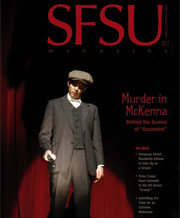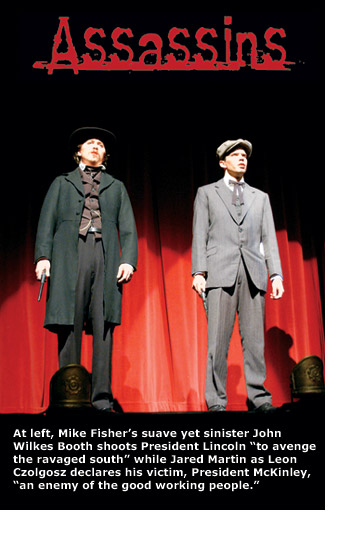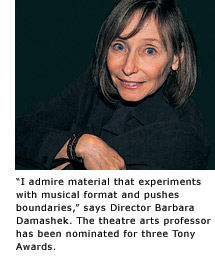 |
| |||
A Killer Performance The Theatre Arts Department Ends the Semester with a Bang First there's a warning. As the stage lights dim, an announcement comes over the loudspeaker: "This show contains lots of loud gunshots and smoke." The loud noises, however, are perhaps the least disturbing part of "Assassins." Professor Barbara Damashek, who directed SFSU's springtime production, calls the 1990 John Weidman and Stephen Sondheim work "one of the most audacious musical pieces in theater created in this country." The musical, which hit Broadway just days after it opened at SFSU, explores the motivations of presidential assassins throughout history, starting with John Wilkes Booth, who politely excuses himself from stage upon hearing a distant announcement of President Lincoln's arrival. In the opening scene John Hinckley approaches a shooting gallery. The proprietor slides a gun in his direction. "C'mere and shoot a president," he sings to Hinckley, "and get the prize with the big blue eyes." The prize is Jodi Foster, represented by a doll appropriately dressed in a pink "Taxi Driver" ensemble. Hinckley takes the gun, as do seven others who are ready to take a shot at a U.S. president. Each one is lured to a gun by a different desire: love, fame, revenge, and in one case, a cure for a stomach ache. As the assassins explain in their opening number, "Everybody's got a right to be happy. Everybody's got a right to their dreams." The vaudeville-style musical, which ran at SFSU from April 29 to May 9, is one in a series of productions that are bringing musical theater back to SFSU after a nearly 10 year absence. Several years ago, theatre arts chair Roy Conboy joined forces with music and dance faculty Alissa Deeter and Patricia Taylor Lee to increase opportunities for talented performers to take to the stage at SFSU. A key part of their strategy was hiring Damashek, who has directed at some of the most prestigious theaters in the country. "âAssassins' was much larger in scale than anything done here previously. It was a tremendous effort," Damashek says, adding that it was also "a signifier of more challenging material to come." During the spring semester, SFSU Magazine went behind the scenes of "Assassins" to find out how students and faculty pulled off one of the biggest and boldest musical productions in the history of the Theatre Arts Department. Jeans for Oswald "Do we have jeans for Oswald?" he asks the group. They've got the pants but are short one pair Talk turns to a civil war soldier's brief appearance. "He's seen for, like, two minutes -- I wish we could just do a cardboard cut-out," Roehrman jokes. It's understandable he's looking to reduce the team's workload. Most of the actors require costumes times two: one in color and another in black and white. "In the opening scene there's a gray scale in the costumes," Roehrman explains. "The notion is that they're stepping out of the annals of history." The Assassins' Accomplices Stage manager, senior Patrick Naylon, keeps track of the myriad details. "It's a 24-7 job," he says. Before, between and after classes Naylon sorts through dozens of e-mails from cast, crew and faculty to address questions and concerns. Today, after the head of each crew has delivered a progress report, he makes it clear that anyone who misses training later in the week will not be allowed to touch the guns. Professor Matthew Miller, the production manager, calls to the students as they grab their backpacks and file out the classroom door, "Keep people enthused -- remember this will all be over in four weeks." Inside the Mind of a Murderer ("She's big on research," a student seated in the audience explains.) Booth offers Oswald an entirely different way out of his failed marriage and failed life: "Shoot a president." Booth assures him that this will get him the respect he deserves. "All your life you've been a victim, Lee," he says. Damashek interrupts. She tells Sells that his reaction to Booth's words requires more intensity. "A victim is the worst thing you can call a victim," she says. "Try to think of someone who knows you -- can really push your buttons -- parents or a sibling." As the scene continues, Booth calls his fellow assassins from the past to join him on stage. The villains, dressed in black and white, beg Oswald to assassinate President Kennedy, so that together they can be "a force of history." As encouragement, Booth offers, "Imagine people having passionate feelings about you." Be Sure of Your Target Hagar explains that the barrels of the starter pistols, derringer and revolver that the students will be shooting, are plugged. Some of the guns disperse gas out both sides of the gun barrel. This means that no one should be on either side of an actor who is preparing to shoot. "Be sure of your target," he says. Nicole Helfer, who plays Sara Jane Moore, the bumbling housewife who failed in her attempt to shoot Gerald Ford, is the first to rush to the stage to try out a single action revolver. "You don't have to cock -- just pull the trigger," Hagar tells her. Helfer fires. "Cool!" she says. Hagar gently removes the gun from her hands. "Let's not get too excited," he says. Music, Maestro In "Assassins" the musical numbers shift to reflect the time period in which each character lived. Hinckley has a disco ballad. Guiteau, James Garfield's assassin, has a cakewalk. Booth has early American folk ballads. Perhaps the most memorable musical moment is a duet sung by Hinckley and Lynette "Squeaky" Fromme, a disciple of Charles Manson, who attempts to shoot Gerald Ford to bring more fame to her beloved "Charlie." She sings that she's unworthy of his love. Hinckley professes that he would "move mountains" and "swim oceans" for Jodi (later he decides he would also shoot Ronald Reagan for the actress). The orchestra's 11 students and three professionals have to stay on top of the speed of scene changes and the delivery of lines, as well as the tempo of each song. Toward the opening of the show, Nies works with Damashek to establish the precise moments when the orchestra will begin and end each number. Nies says that each production involves a search for its "unique rhythm." Getting Technical The theater poses huge acoustical challenges for the sound crew. Sound engineer, junior Mike Gurnari, strives to achieve a balance between the actors' voices and the orchestra. It's not easy. Meanwhile, several microphones simply will not stay attached to their actors. Lighting poses its own challenges. Lighting designer, junior Lauren McCullough, and her crew must adjust a series of lighting instruments at the slightest change in feeling or mood. A single song can require a dozen adjustments, from happy, warm pink lights to the sinister look of "uplighting," light cast on the actors' faces from below. Senior Kirk Livingston, who plays assassin Charles Guiteau, finally gets a chance to try out the stairs for his show-stealing scene. After he shoots Garfield, he performs a snappy song and dance as he climbs the steps to the gallows. Although the steps are quite high, narrow and lack any kind of railing, he navigates them with ease. He has been practicing on a stairway inside his apartment building. The Curtain Rises Noemi Margaret, who lives close to campus but has no ties to the University, brings her housemates to check out "Assassins," her first theater experience at SFSU. "It is wondrous. The voices and acting are superb, the costumes and sets are beautiful," she says. "It's just what a theater night should be, and nothing like the over-produced, over-priced stuff downtown." She and her friends leave singing the Sondheim tunes and plan on returning to campus to see "Assassins" a second time. Jeff Kaliss, an independent Bay Area theater critic, is also impressed. He says "Assassins" was well worth a trip to campus: "It's an evening of uneasy but fascinating entertainment." -- Adrianne Bee See more scenes from "Assassins" and a list of notable stars who began their careers at SFSU. | ||||











